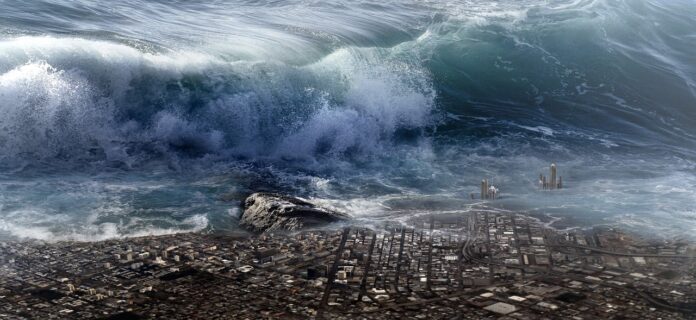A tsunami is a series of powerful ocean waves caused by underwater disturbances like earthquakes, volcanic eruptions, or landslides. These waves travel across the ocean at high speeds and can reach great heights when they approach shallow coastal areas, causing widespread destruction.
Tsunamis can flood coastal areas, demolish buildings, and claim many lives. Early warning systems and evacuation plans are crucial for minimizing the impact of these natural disasters. Tsunamis remind us of the immense power of nature and the importance of being prepared to respond swiftly and effectively.
Interesting Facts About Tsunamis
- The word “tsunami” comes from the Japanese words “tsu” (harbor) and “nami” (wave).
- Tsunamis can travel across the ocean at speeds of up to 500 miles per hour (800 kilometers per hour).
- In deep water, tsunami waves can be less than a foot high, making them difficult to detect.
- As tsunamis approach shallow coastal areas, their speed decreases, but their height increases dramatically.
- The 2004 Indian Ocean tsunami was one of the deadliest in history, killing over 230,000 people in 14 countries.
- Tsunamis are most commonly caused by underwater earthquakes at tectonic plate boundaries.
- Volcanic eruptions, underwater landslides, and meteorite impacts can also trigger tsunamis.
- The Pacific Ocean is the most tsunami-prone area, due to its “Ring of Fire” with numerous tectonic activity zones.
- Tsunamis are sometimes incorrectly called “tidal waves,” but they are not related to tides.
- The first sign of an approaching tsunami can be a rapid and unexpected recession of water from the shore.
- Tsunami waves can range in height from a few inches to over 100 feet.
- The 2011 Tōhoku earthquake and tsunami in Japan caused a nuclear disaster at the Fukushima Daiichi power plant.
- Tsunamis can travel across entire ocean basins; for example, a tsunami generated off the coast of Chile can reach Japan.
- Tsunami warning systems use seismographs, buoys, and communication networks to detect and warn about tsunamis.
- “Tsunami stones” in Japan, some over 600 years old, mark the high-water points of past tsunamis.
- Tsunami waves can arrive in multiple surges, with the second or third wave being the largest.
- Tsunamis can cause severe flooding and contaminate freshwater supplies with saltwater.
- Coral reefs, mangroves, and coastal vegetation can help reduce the impact of tsunamis by absorbing some of the wave energy.
- Tsunami evacuation plans and drills are essential for communities in tsunami-prone areas.
- The 1755 Lisbon earthquake and tsunami destroyed much of Lisbon, Portugal, and affected coastlines across Europe and North Africa.
- The Indian Ocean tsunami led to the creation of the Indian Ocean Tsunami Warning and Mitigation System.
- Tsunami waves can wrap around obstacles like islands and peninsulas, causing damage on the opposite side.
- Tsunami debris can travel across oceans; for example, debris from the 2011 Japan tsunami washed up on North American shores.
- In 1883, the eruption of Krakatoa in Indonesia generated a massive tsunami that killed over 36,000 people.
- Tsunamis can generate strong currents and whirlpools, posing additional hazards to ships and boats.
- The 1958 Lituya Bay megatsunami in Alaska generated waves over 1,700 feet high, the tallest ever recorded.
- Animals sometimes exhibit unusual behavior before a tsunami, possibly sensing the seismic activity.
- Tsunamis can disrupt ecosystems, erode coastlines, and destroy habitats.
- Tsunami education and awareness programs are crucial for reducing the loss of life and property.
- After a tsunami, it can take years for affected communities to rebuild and recover from the devastation.
